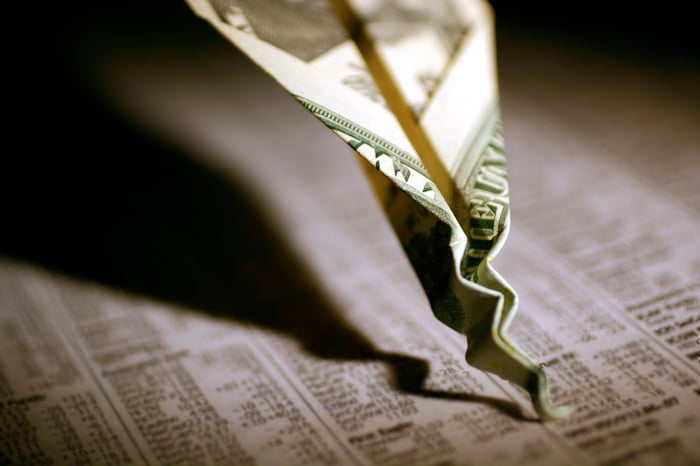In less than a week we'll be ushering out 2019 and welcoming an entirely new year and decade. But investors are probably going to be sad to see the 2010s go. After all, despite a number of mild stock market corrections, it's the only decade in history that the U.S. economy began and ended without a recession.
Furthermore, the broad-based S&P 500 (^GSPC -0.41%) is just a stone's throw from logging a 30% gain for the year, which would be more than four times its historic annual average gain of closer to 7%, inclusive of dividend reinvestment and adjusting for inflation. It's been an excellent year (and decade) to be an investor.
But the party could be nearing an end, according to data from investment bank Credit Suisse.

Image source: Getty Images.
The yield-curve inversion spells (eventual) doom
Chances are that you've probably heard all about the biggest recession red flag of them all in 2019: the yield-curve inversion. It's the tea leaves of this inversion that, according to Credit Suisse, suggest the U.S. economy is in deep trouble.
The yield curve is a visual representation of the various yields, relative to maturity, of U.S. Treasury bonds. Generally speaking, we'd prefer to see an upward-sloping yield curve, which is to say that longer-maturing bonds (say 10 years or 30 years) should bear higher yields than shorter-term bonds (say three months or two years). This makes sense given that lenders expect a premium return for having to part with their money for a longer period.
Of course, the yield curve doesn't always work as expected. In late Aug. 2019, the yield curve between the highly watched two-year and 10-year Treasury bond briefly inverted, with the yield for the two-year peaking at 4 basis points higher than the 10-year. An inverted yield curve has preceded every recession since the end of World War II, though not every yield-curve inversion has been followed by a recession.
What's worth noting, per the Credit Suisse data, is that all five yield-curve inversions since 1978 have been followed by a recession. Although this is cherry-picking the data a bit, perception can certainly become reality if enough investors believe in it. On average, it's taken 22 months for a recession to hit following a yield-curve inversion, and 18 months for the stock market to begin rolling over. This puts the stock market on track to roll over during the first quarter of 2021, and for the U.S. economy to enter a recession by mid-2021, if these averages hold.

Image source: Getty Images.
But wait -- there's more
The problem for investors is that the yield curve is only part of the worry. Because it's such a rare event, it tends to receive a lot of media coverage. But there are plenty of other issues that could prove detrimental to the U.S. economy and/or broader market.
The elephant in the room continues to be the trade spat with China. Although a phase 1 deal has been reached and a number of tariffs will be reduced, the recent trade history between the countries and their leaders suggests that this initial agreement should be taken with a grain of salt. It wouldn't take much for the trade war to again escalate, which would be worrisome for the Chinese and U.S. economies.
Another concern comes from the manufacturing sector, with the ISM Purchasing Managers Index (PMI) registering its fourth consecutive month below 50% in November. Any reading below 50 represents contraction in the manufacturing sector. Worse yet, the ISM PMI from September was the lowest reading since June 2009! Although manufacturing doesn't play the same key role in the U.S. economy that it did, say, four decades ago, it's still a notable contributor to U.S. GDP and jobs.
We've also witnessed a substantive climb in corporate debt levels over the past decade. Historically low interest rates have enticed businesses to borrow on the cheap, which is an especially attractive proposition for high-growth businesses. However, with corporate debt now equal to about 48% of U.S. GDP, up from 44% of U.S. GDP prior to the Great Recession, it's conceivable that businesses may have overlevered themselves and could struggle to pay back this debt if the U.S. or global economy "hiccups."

Image source: Getty Images.
Here's what investors need to do
There certainly appear to be a confluence of factors building up that suggest a recession is coming. However, this really shouldn't surprise investors given that recessions are an inevitable part of the economic cycle, no matter what sort of fiscal or monetary policy is in place.
In reality, recessions can prove to be godsends for investors, as they offer an opportunity to buy into high-quality businesses on the cheap. Remember, despite 37 corrections of at least 10% in the S&P 500 index since the beginning of 1950, each and every downward move has eventually been erased by a bull-market rally.
So what should investors do in light of this information? Well, for one, I'd have a stable of cash handy with which to invest on any substantive dip in the stock market. This doesn't mean you can't continue to make new investments or dollar-cost average into existing investments, but it wouldn't hurt to have some reserve cash handy to take advantage of the next inevitable stock market correction.
The other consideration here is to buy dividend stocks with regularity. Dividend-paying companies are often profitable and have time-tested business models. In other words, they can weather the worst of what the economy has to offer.
For example, AT&T (T 1.92%) may have a relatively boring business model that's underperformed the broader market in recent years, but investors who buy into AT&T don't have to worry about much. This is a company that successfully leans on the predictability of cash flow in its wireless, television, and burgeoning streaming businesses, and has increased its annual payout for 36 consecutive years. AT&T's business model will hardly flinch when the next recession strikes.
The point is, investors shouldn't fear the next recession, even if the data suggests it's potentially right around the corner.




